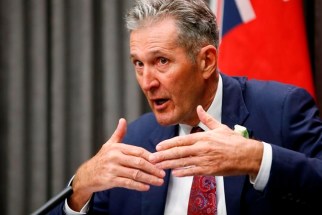Public crisis demands public data
Read this article for free:
or
Already have an account? Log in here »
To continue reading, please subscribe:
Monthly Digital Subscription
$0 for the first 4 weeks*
- Enjoy unlimited reading on winnipegfreepress.com
- Read the E-Edition, our digital replica newspaper
- Access News Break, our award-winning app
- Play interactive puzzles
*No charge for 4 weeks then price increases to the regular rate of $19.00 plus GST every four weeks. Offer available to new and qualified returning subscribers only. Cancel any time.
Monthly Digital Subscription
$4.75/week*
- Enjoy unlimited reading on winnipegfreepress.com
- Read the E-Edition, our digital replica newspaper
- Access News Break, our award-winning app
- Play interactive puzzles
*Billed as $19 plus GST every four weeks. Cancel any time.
To continue reading, please subscribe:
Add Free Press access to your Brandon Sun subscription for only an additional
$1 for the first 4 weeks*
*Your next subscription payment will increase by $1.00 and you will be charged $16.99 plus GST for four weeks. After four weeks, your payment will increase to $23.99 plus GST every four weeks.
Read unlimited articles for free today:
or
Already have an account? Log in here »
Hey there, time traveller!
This article was published 05/11/2020 (1859 days ago), so information in it may no longer be current.
The more unwilling the provincial government is in releasing key and timely pandemic-related information, the less confident Manitobans will be government is making the right decisions.
The greater the erosion of that trust, the tougher it could be to get people to buy into public health orders.
Governments are reluctant to release information about their operations at the best of times. Politicians and senior officials often jealously guard public records, violating the spirit — if the not the letter — of freedom of information laws on a regular basis.
It doesn’t matter who is in office. Denying access to what should be public information has been embedded in government culture at the provincial and federal level for decades.
However, the stakes are higher during a public emergency. When civil liberties are suspended and businesses are forced to cease operations, the right to know what’s going on behind closed doors takes on a whole new meaning.
Attempts to get even the most basic data from the Manitoba government during the COVID-19 pandemic about hospital operations, staffing levels, contact tracing, and epidemiological survey information has been frustratingly, and unnecessarily, difficult.
Whether it is requests for data about how long it’s taking contact tracers to follow up with people who have tested positive for COVID-19, or trying to get details about off-site hospital expansions, government’s response is often the same: don’t have it, can’t compile it or are unable to release it.
Chief provincial public health officer Dr. Brent Roussin was asked during Wednesday’s news conference how many people the province had devoted to contact tracing. It is an oft-asked question. Roussin said he didn’t have that information.
He was asked what the R0 value was for COVID-19 in Manitoba (average number of secondary infections). Roussin said he didn’t know.
On contact tracing, Roussin said “many cases” are now being followed up by staff within 24 hours but he wouldn’t say how close they are to meeting the provincial benchmark of 90 per cent within 24 hours (a number the Free Press has been requesting for weeks).
How many more hospitals beds will be needed in the coming weeks based on case projections? Roussin said he didn’t know.
What percentage of close contacts is the province connecting with to ensure they’re self-isolating? Officials won’t say.
What percentage of close contacts have become infected? The province doesn’t have that number or won’t release it.
What percentage of infected people who required hospitalization were infected while in hospital? No available data.
The difference between how information is released during the COVID-19 disaster and the 1997 “Flood of the Century” is stark.
During that public emergency, there were daily briefings in the media room in the basement of the legislature. Leaders from multiple departments and agencies, including the Emergency Measures Organization, answered technical and logistical questions on a wide range of issues. If they couldn’t, support staff would get it.
Accurate, timely information was seen as a critical piece in getting everyone to pull together to fight a common threat. Government made decisions based on evidence it was willing to share with the public.
Manitoba posts some pandemic information online, including weekly epidemiology reports, but they contain very limited information. By contrast, provinces such as Ontario and Quebec post a wide range of epidemiological data and hospital information on their official websites, including interactive and reader-friendly graphs and tables.
Premier Brian Pallister says we’re all on “Team Manitoba” and everyone needs to row in the same direction. Yet, he spent a considerable amount of time this week ranting about unfair treatment from the media or whining about how his government has done everything possible (and it’s really a few “scofflaws” spreading the virus who are to blame).
Manitobans could do with less politically-charged rhetoric and more accurate, useful information.
If they don’t get it, Pallister may see more people on Team Manitoba rowing in different directions.
tom.brodbeck@freepress.mb.ca

Tom has been covering Manitoba politics since the early 1990s and joined the Winnipeg Free Press news team in 2019.
Our newsroom depends on a growing audience of readers to power our journalism. If you are not a paid reader, please consider becoming a subscriber.
Our newsroom depends on its audience of readers to power our journalism. Thank you for your support.






